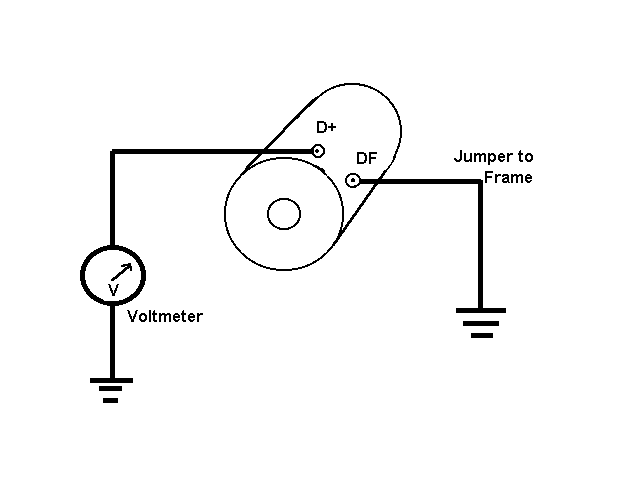
GENERATOR TESTING
NOTE: These tests are for 12V generators. The same tests will work on 6V generators but the voltages will be roughly one half the 12V values.
Is my generator charging?
If you have a voltmeter, here are some easy tests to make:
Measure the voltage across the battery. Should be about 12.6 volts with the engine off. As the engine speeds up, the voltage should increase to somewhere around 14 volts. If it does, the generator is working and charging the battery.
If the voltmeter does not go up with the engine running, first check to see that the generator brushes are not worn excessively. If you can, apply a little pressure to the brushes while the engine is running and see if the gen light goes out or the voltmeter reading increases.
If it does, the brushes may be worn to the point that they don't exert enough pressure on the commutator.
Generator Testing
If the brushes check OK, do this test:
Disconnect the generator from the regulator (probably easiest to simply
take the wires off the generator).
Connect a jumper from DF on the generator to the generator frame.
Now run the engine and measure the voltage from ground to D+
on the generator.
NOTE: Some generators have different types of terminals;
verify which is DF and which is D+.
As you increase the engine speed, the voltage should jump up to +35
volts or so (@3000 RPM).
If it passes this test, the generator is good.
(Don't run this test longer than necessary as it will overheat the generator.)
Polarizing
If it fails that test, the generator may need to be polarized.
Leave the jumper wire connected from DF to ground.
Remove the fan belt.
Connect a wire from the battery + terminal to D+ on the generator.
The generator shaft should start to spin.
Don't run this way for more than a few seconds to avoid overheating.
The generator will now be properly polarized.
If the generator did not spin during this motoring test,
the generator is likely defective.
Put the belt back on and re-test for generator voltage with DF grounded. If the output voltage is still low, the generator is defective.
About polarizing
Why do generators need to be "polarized". Auto generators need some magnetism to get started. This "residual" magnetism remains in the Field pole pieces even after the engine has stopped.
The next time the generator starts up, the residual magnetism creates a small
voltage in the Armature windings. Not enough to charge the battery,
but enough to allow the Field windings to draw current. As the Field current
increases, the pole pieces create even more magnetism. That makes even
more voltage in the Armature, and the cycle continues until the
generator is capable of producing maximum output.
What happens though to a generator which has been stored a long time or is freshly built? The residual magnetism may have decreased to the point where it can no longer get the generator started producing voltage. In the case of a new generator or one which has been mis-treated, the residual may even be of the wrong direction (North and South poles reversed).
Polarization is a simple process used to restore the Field pole residual magnetism and ensure the magnetic direction is correct.
Do regulators need to be polarized?
No, regulators are not polarity-sensitive.
But my regulator came with instructions to polarize it...
These instructions actually polarize the generator, not the regulator.
The regulator mfr simply wants to ensure that your generator will work
properly so you don't blame the regulator.